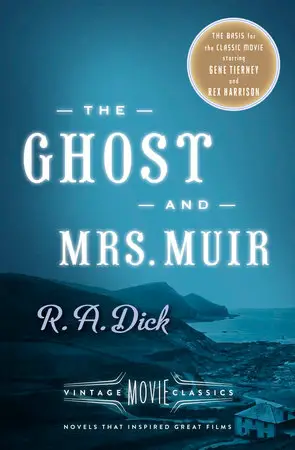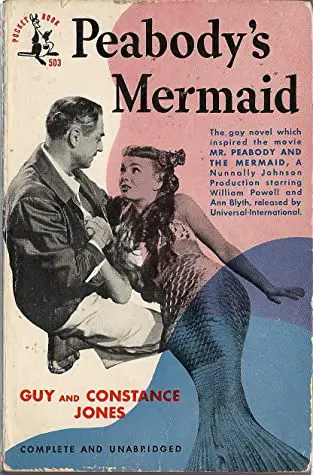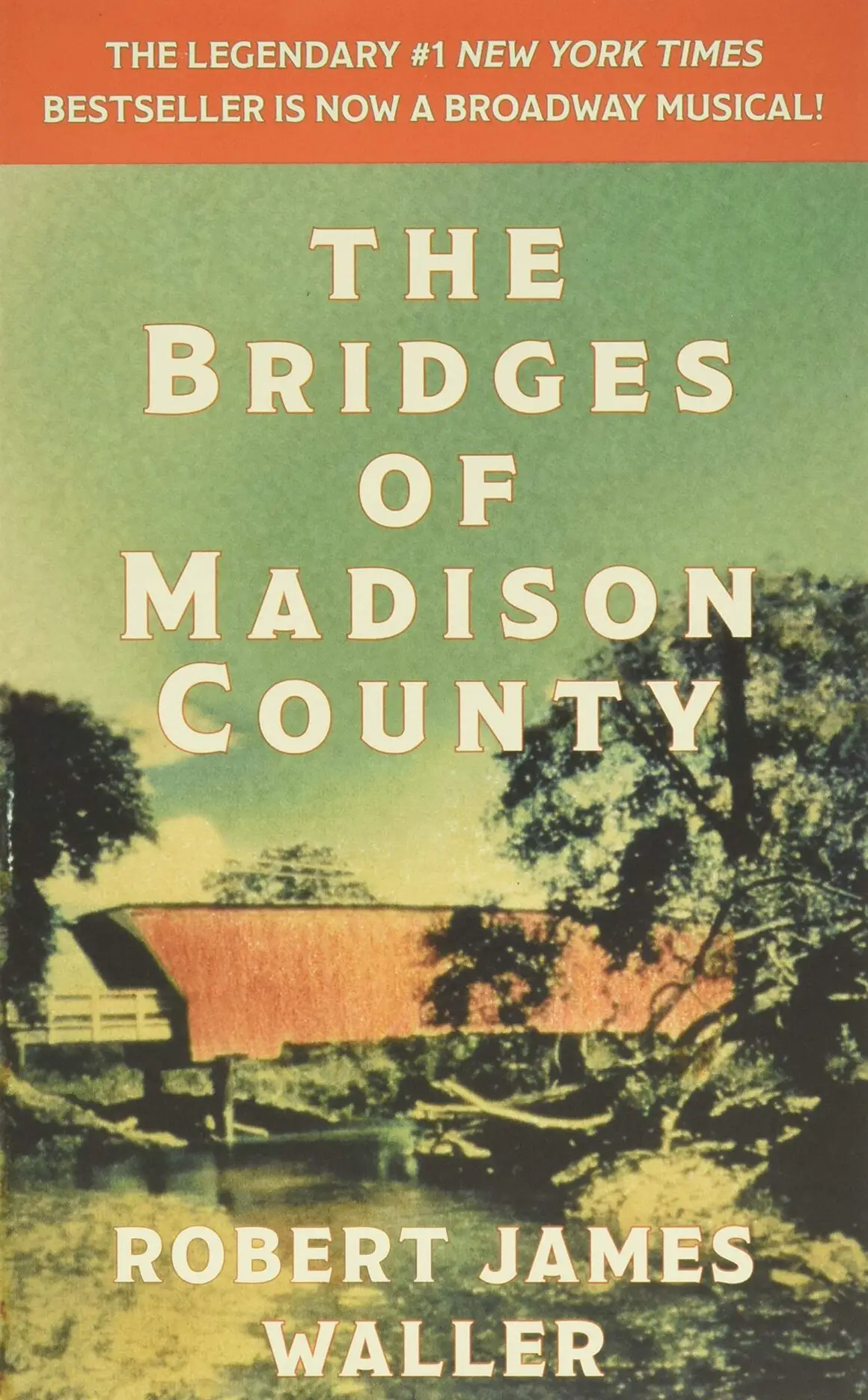What is it about loving a ghost or a mermaid, the transformative memory of a passionate night or weekend, or the steadfast belief in love-at-first-sight, that makes such romantic interludes more desirable than the closer-to-home real thing? Once upon a time, I read an article about the value of ideal love from a distance in time and place. The author examined the theory that love kept alive from afar works more smoothly than married or long-term relationships where life’s problems, irritations, and daily routines get in the way.

Are these fantasies simply the stuff of dreams and imagination, magical and ephemeral? Gratification beyond the reach of our commonplace lives? No angst, just desire and adventure in another realm, be it after death or beneath the sea? When the rose-colored glasses come off, do we seek fulfillment elsewhere? If only…what? I find this question thought-provoking with no clear answer, but as literature and film often reflect the push-pull of romantic fantasies and ‘what ifs’ versus reality, their intersection is a viable theme worth contemplating.
Happily Ever After or its Nonexistence
A hilarious conversation about true love and the idea of “Happily Ever After” (or not) occurs in the Disney film Enchanted, an admixture of elements from story-book fairy tales that dispels notions of Prince Charming rescuing the maiden. Divorce lawyer Robert and fairy tale animated beauty-turned-human Giselle discuss her fiancé, the charming Prince Edward, and why she believes he will come to New York to find her. As they walk through Central Park, Robert asks her, “How long have you been together?” Giselle answers, “About a day.” Robert exclaims, “About a day, one day? You’re joking. How can you talk about loving some guy you don’t know?” Giselle answers, “I know what’s in his heart.” Robert says, “You meet, you fall in love, you have lunch, you marry.”
About love, Robert calls it “complicated” and says, “Most marriages are considered a success if they manage not to end, period. Forget about happiness.” While Enchanted does end on a pseudo-fairy tale note, it’s not the usual story at all. It is a case in point for contemplating unreal romance vs the real thing. Onward to the ghosts, sea creatures, et al. and rollicking good times ahead.
Ghostly Escapades
Topper – Thorne Smith
Topper is a farcical book by urbane humorist Thorne Smith that was published in 1926. “(Thorne Smith) created the modern American ghost. A ghost with style and wit. A ghost that haunts us still.” – The New York Times

Staid and buttoned-down banker, Cosmo Topper, at first leads a dull and respectable “same old” existence with his dyspepsia-suffering wife whose greatest accomplishment is cooking a leg of lamb for her husband (who couldn’t care less). Topper’s life takes a dramatic U-turn when he buys a snazzy revamped used car whose prior owners, the deceased, hedonistic couple, George and Marion Kerby, had smashed it into an oak tree. A ‘joy ride’ of an adventure ensues and takes place in real-time, as the couple leads Topper astray, drinking and carousing through the countryside.
“No man’s life could have undergone more radical alteration,” he muses. Topper’s respectability diminishes, but ribald adventures in his pursuit of love-interest and the spirited Marion (who materializes through ectoplasm with an assortment of odd-lot ghosts including half-a-dog Oscar) replaces it. “The past is made of memories, the future is made of dreams,” Marion tells Topper, who decides that being predictable is boring and that he has been “lifted out of the rut of my own existence.” The novel Topper became a film and then a television show, and through the years remains in the public consciousness, an escapist ideal where one can shake the bonds of boredom and virtue, become more self-reliant, and live life to the fullest. There’s a ghost of a chance for success.
The Ghost and Mrs. Muir – R.A. Dick
The Ghost and Mrs. Muir is a 1945 book by R.A. Dick (Irish writer Josephine Aimee Campbell Leslie knew that using initials and what I consider a double entendre pseudonym would give her a better chance at publication.)

Often referred to as “poor little Lucy,” the young widow with feminist leanings in Victorian England who yearns for a life of possibilities is far from that designation. Desperate to escape the interference of her badgering relatives but left with minimal funds, she and her son and daughter move into the purportedly haunted but cheap Gull Cottage in the seaside village of Whitecliff. Ghosts apparently have no boundaries and neither does the resident haunt, Captain Daniel Gregg, a bold, handsome adventurer who evidently died from an accident caused by a gas heater explosion in the house.
He presents himself to Lucy as a sort of vision and their initial quick-witted encounter foreshadows what the relationship will become. “You can call me Daniel,” Captain Gregg says. “That’s very good of you,” Lucy answers. “And I shall call you Lucia.” “My name is Lucy.” He says, “It doesn’t do you justice, my dear. Women named Lucy are always being imposed upon. But Lucia – now there’s a name for an Amazon. For a queen.” Her last name, Muir, is actually Gaelic for “the sea” and Lucia means “light” in Italian.
Time passes and Mrs. Muir’s source of funds dissolves, which causes Captain Gregg to dictate his memoirs Blood and Swash to her in salty language, sparing no details of his racy, gritty, bold adventures at sea. She sells the book to a publisher, meets and falls for the faithless Miles Fairley, and over time, believes her interactions with Captain Gregg were part of a dream. A legendary ever-popular tale for the ages.
Tryst – Elswyth Thand (1939)
This charming paranormal romance takes place against the backdrop of impending World War II in 1939. Seventeen-year-old Sabrina Arche accompanies her father and Aunt Effie to a 9-bedroom country house called Nuns Farthing in England. Professor Arche wants to explore ancient encampments in the area while working on his book. They’ve rented the house from the Shenstone family for a year with the stipulation that they must not enter the locked room at the top of the stairs, which belonged to their second son, Hilary Shenstone, reportedly missing in action.
Related: Love Defies Time: Portrait of Jennie & Somewhere in Time
Sabrina, on the cusp of womanhood and so troubled by insecurities that she “lay awake in the dark in a hopeless funk,” is ready for a way for her world to “right itself.” She picks the lock and manages to enter the off-limits room. Once inside, via journals and books, she senses the voice and presence of deceased British secret agent Hilary who had been hit with a stray bullet on his last mission. Sabrina reads and learns more about him as his ghost leaves writings for her. As here (or hereafter) runs the course of true love, dashing Hilary becomes the man of her dreams. They were destined to meet and be together eternally. If one can fall head over heels with a romance where you wholeheartedly root for the fateful outcome, Tryst is the one.
Siren’s Song
Peabody’s Mermaid – Guy & Constance Jones
Book by Guy and Constance Jones (1945); Film, William Powell and Ann Blyth, Universal-International

“Teach me to hear the mermaids singing.” – John Donne
This proverbial “fish out of water” tale features American Arthur Peabody, who is recovering from an illness and vacationing on a Caribbean island with his young wife, Polly. Caught between British society, their mores and snobbery as well as constant chatter, he suffers in the doldrums of a life devoid of romance (Polly tells him he is not romantic and he agrees with her assessment).
Peabody decides to venture out on The Amberjack to go fishing, where he hears an angelic, unearthly voice drifting from Cay Oro. He captures the beauteous mermaid, names her Min, hides her in his wife’s bathtub filled with bubbles, and then transfers her outside to the Villa Marina’s deep pond. Oddly, she understands everything Peabody says, feels jealousy toward other women, and the attraction, while legendary, cannot last. Everyone, including the F.B.I., wants to see Peabody’s great catch. Is she the one that got away?
*Please note that while books with outdated elements can contain unacceptable stereotypes and misconceptions, I nonetheless read on and appreciate each story based on its merits in the context of the times in which it was written.
The Shape of Water – Guillermo del Toro and Daniel Kraus
This romance occurs way outside the norm, a truly unique love story where a mute woman who cleans a government laboratory falls in love with the amphibious sea creature monster (The Asset) caged there. One critic called it “A fairy tale for troubled times.” This underwater story takes love to new, uniquely beautiful depths. Who would have imagined such a tale?

Interludes to Last a Lifetime
Two stories about extra-marital affairs enthralled the public, who sided sympathetically with the romanticism of adultery. The first, The Bridges of Madison County by Robert James Waller, involves Italian-American farmwife, Francesca Johnson. Her torrid weekend affair with a photographer capturing photos of a covered bridge near her home in Iowa defines her life from then on. They never meet again.
Same Time Next Year by playwright Bernard Slade (1975) recounts the 24-year affair of a fictional couple who are married to long-time loves yet attracted to each other. They share their lives and events once a year. Slade thought he was “writing a fantasy” but found the reality of the theme relatable to many.
Glorified Love’s True Counterbalance
Certainly, we can admire surreal and fantasized romances to our heart’s content. Artists have created such ideals for eons. But for those of us engaged in the long-haul of true, real committed love, look to Shakespeare who said it best in Sonnet 116: Let me not to the marriage of true minds.
Let me not to the marriage of true minds
Admit impediments. Love is not love
Which alters when it alteration finds,
Or bends with the remover to remove.
O no! It is an ever-fixed mark
That looks on tempests and is never shaken;
It is the star to every wand’ring bark,
Whose worth’s unknown, although his height be taken.
Love’s not Time’s fool, though rosy lips and cheeks
Within his bending sickle’s compass come;
Love alters not with his brief hours and weeks,
But bears it out even to the edge of doom.
If this be error and upon me prov’d,
I never writ, nor no man ever lov’d.
